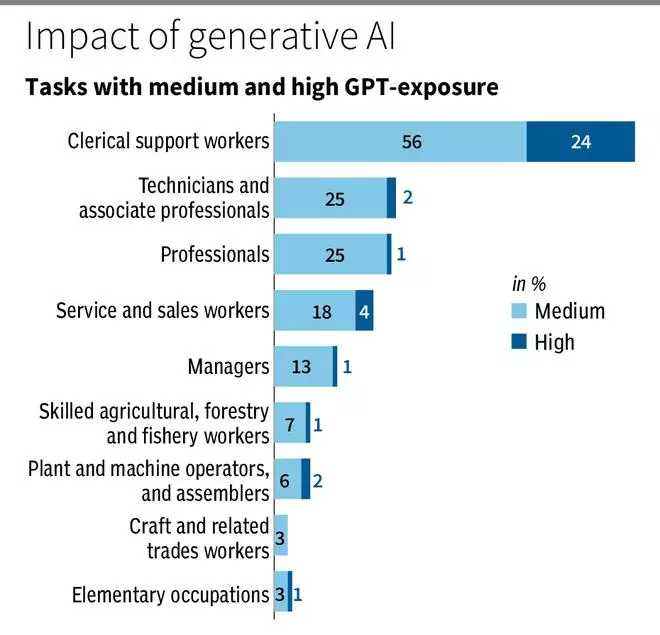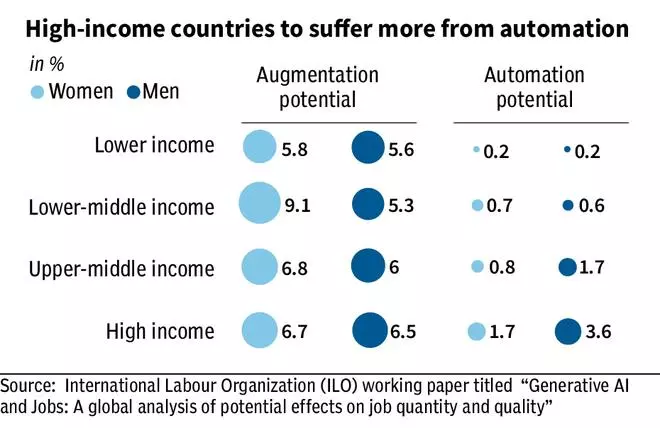The recent working paper from the International Labour Organization (ILO) titled, “Generative AI and Jobs: A global analysis of potential effects on job quantity and quality”, has claimed that the most important impact of Generative AI technology is likely to be on aiding in work (augmenting) as opposed to fully automating occupations.
The paper, authored by Paweł Gmyrek, Janine Berg, and David Bescond, and published last month, delves into a thorough examination of how various occupations and tasks worldwide might be affected by Generative AI, with a particular focus on Generative Pre-Trained Transformers (GPTs). Moreover, the paper sheds light on the potential consequences of GPT exposure, both in terms of job quantity and job quality.
Exposure to AI means that the most important tasks could be replaced or assisted by the technology. Researchers used the GPT-4 model to estimate task-level scores of potential exposure and then estimated potential employment effects at the global level as well as by country income group. GPT-4 is a large multimodal model (accepting image and text inputs, and emitting text outputs).
Which occupations will be affected?
Researchers found that only clerical work is highly exposed to the technology with 24 per cent of clerical tasks considered highly exposed and an additional 58 per cent with medium-level exposure. A full 82 per cent of clerical job tasks are exposed at an above-average level.
Interestingly, among the remaining occupational categories, the highest proportion of tasks with significant exposure fluctuates within the range of 1 to 4 per cent, while tasks with moderate exposure never surpass 25 per cent. (see graphics)

Aurgumentation and automation
The researchers tracked the potential employment effects of augmenting and automating, varying widely across country income groups, due to different occupational structures.
Augmentation enhances human capabilities, assistance provides support and guidance to humans, and automation replaces or reduces human involvement in tasks. These concepts can overlap in some cases, as AI systems may combine elements of augmentation, assistance, and automation to achieve specific goals.
The paper shows that in low-income nations, merely 0.4 per cent of overall employment could potentially face automation impacts, whereas in high-income countries, this percentage increases to 5.5 per cent. The research findings highlight a significant gender disparity, indicating that more than twice as many women are at risk of potential automation effects.
Augmentation, on the other hand, is the primary driver of impact, with the potential to influence 11.4 per cent of employment in low-income nations and 13.2 per cent of employment in high-income nations.

“However, such effects do not consider infrastructure constraints, which will impede the possibility for use in lower-income countries and likely increase the productivity gap,” the study reports.
Other studies
Researchers of the paper have referred to some other studies, showing that their findings align with some of the most-recent literature on generative AI systems with a global focus.
A study by McKinsey in 2023 identifies a comparable set of “knowledge work” occupations and tasks with the highest exposure levels, albeit with a notably higher projected displacement rate.
The WEF’s 2023 global survey, which primarily concentrated on large enterprises, includes clerical and administrative positions in its list of occupations anticipated to experience rapid declines.
“Estimates provided by Goldman Sachs (2023) suggest a slightly higher level of potential automation than our calculations, but with the general conclusion aligning with our main finding that most jobs and industries are only partially exposed to automation and are thus more likely to be complemented rather than substituted by AI,” the report adds.




